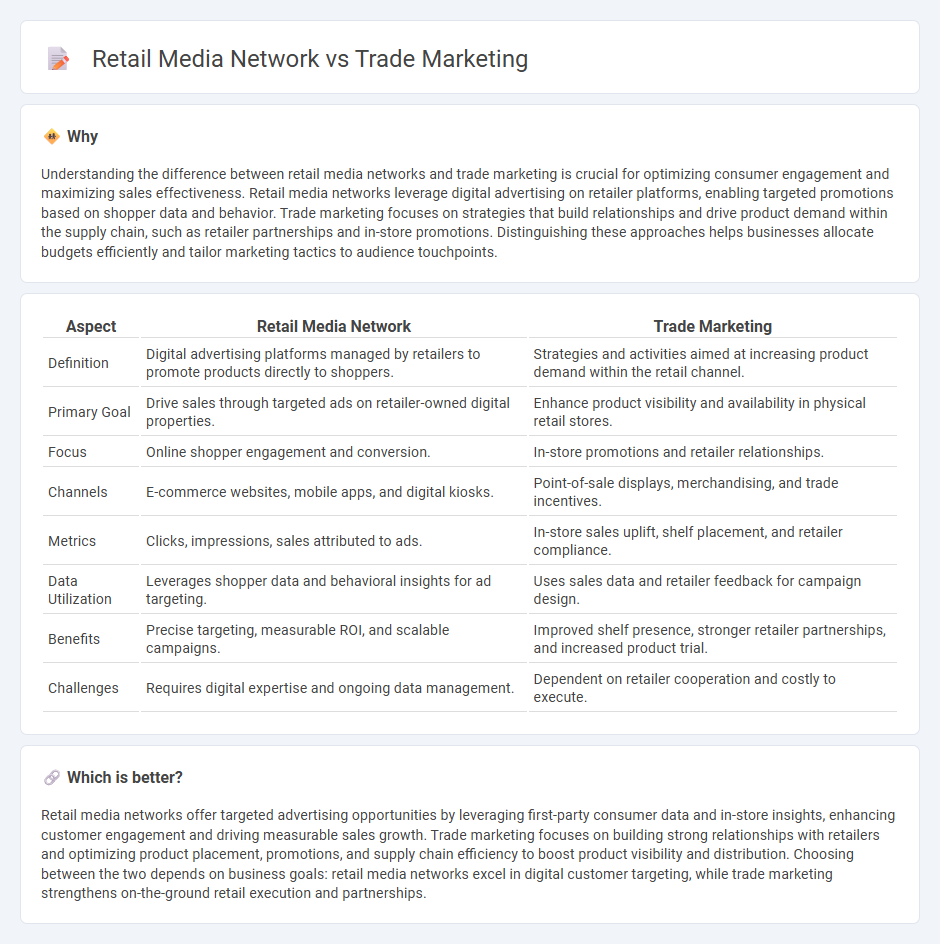
Retail media networks leverage data-driven advertising directly within retail platforms to target consumers at the point of purchase, enhancing engagement and conversion rates. Trade marketing focuses on strategies and promotions aimed at retailers and distributors to optimize shelf placement and product visibility. Explore the key differences and benefits of retail media networks versus trade marketing strategies to boost your commerce success.
Why it is important
Understanding the difference between retail media networks and trade marketing is crucial for optimizing consumer engagement and maximizing sales effectiveness. Retail media networks leverage digital advertising on retailer platforms, enabling targeted promotions based on shopper data and behavior. Trade marketing focuses on strategies that build relationships and drive product demand within the supply chain, such as retailer partnerships and in-store promotions. Distinguishing these approaches helps businesses allocate budgets efficiently and tailor marketing tactics to audience touchpoints.
Comparison Table
| Aspect | Retail Media Network | Trade Marketing |
|---|---|---|
| Definition | Digital advertising platforms managed by retailers to promote products directly to shoppers. | Strategies and activities aimed at increasing product demand within the retail channel. |
| Primary Goal | Drive sales through targeted ads on retailer-owned digital properties. | Enhance product visibility and availability in physical retail stores. |
| Focus | Online shopper engagement and conversion. | In-store promotions and retailer relationships. |
| Channels | E-commerce websites, mobile apps, and digital kiosks. | Point-of-sale displays, merchandising, and trade incentives. |
| Metrics | Clicks, impressions, sales attributed to ads. | In-store sales uplift, shelf placement, and retailer compliance. |
| Data Utilization | Leverages shopper data and behavioral insights for ad targeting. | Uses sales data and retailer feedback for campaign design. |
| Benefits | Precise targeting, measurable ROI, and scalable campaigns. | Improved shelf presence, stronger retailer partnerships, and increased product trial. |
| Challenges | Requires digital expertise and ongoing data management. | Dependent on retailer cooperation and costly to execute. |
Which is better?
Retail media networks offer targeted advertising opportunities by leveraging first-party consumer data and in-store insights, enhancing customer engagement and driving measurable sales growth. Trade marketing focuses on building strong relationships with retailers and optimizing product placement, promotions, and supply chain efficiency to boost product visibility and distribution. Choosing between the two depends on business goals: retail media networks excel in digital customer targeting, while trade marketing strengthens on-the-ground retail execution and partnerships.
Connection
Retail media networks leverage customer data and digital platforms to deliver targeted advertising directly within retail environments, enhancing product visibility and consumer engagement. Trade marketing focuses on building strong relationships with retailers and optimizing product placement, pricing, and promotions to drive in-store sales performance. The integration of retail media networks into trade marketing strategies enables brands to use precise, data-driven campaigns that boost sales and improve retailer collaboration.
Key Terms
Channel strategy
Trade marketing centers on building strong relationships with retailers, optimizing in-store promotions, and enhancing product visibility within traditional retail channels. Retail media networks leverage digital platforms owned by retailers to deliver targeted advertising and personalized consumer engagement, blending data-driven insights with channel-specific strategies. Explore the distinct advantages of these approaches to refine your channel strategy effectively.
Shopper engagement
Trade marketing focuses on strategies that drive shopper engagement at the point of sale, using in-store promotions, merchandising, and product placement to influence purchasing decisions directly. Retail media networks leverage digital advertising within retailer ecosystems to target shoppers with personalized ads based on real-time data and shopping behavior. Explore how integrating trade marketing with retail media networks can optimize shopper engagement and conversion rates.
Data analytics
Trade marketing leverages data analytics to optimize promotional strategies directly within the distribution channels, focusing on shopper behavior, inventory levels, and point-of-sale performance. Retail media networks, on the other hand, utilize advanced data analytics to deliver targeted advertising based on consumer insights harvested from e-commerce platforms and in-store digital touchpoints. Explore the evolving role of data analytics in transforming trade marketing and retail media networks for enhanced ROI and customer engagement.
Source and External Links
Defining What Trade Marketing Means and How To Use It - Shopify - Trade marketing involves strategies companies use to enhance product visibility, demand, and sales by collaborating with retailers and wholesalers through trade shows, promotions, retailer partnerships, strong branding, and digital marketing.
Trade marketing 101: Top tricks of the trade - Incentivesmart - Trade marketing is a B2B approach fostering mutually beneficial relationships between manufacturers and intermediaries like retailers and distributors to increase product availability, visibility, and promotion at retail.
What is Trade Marketing: Strategies and Examples | SendPulse - Trade marketing focuses on promotional activities to encourage wholesalers and retailers to stock and sell products, including discounts, displays, and product demos to increase sales and brand awareness at the point of purchase.
 dowidth.com
dowidth.com